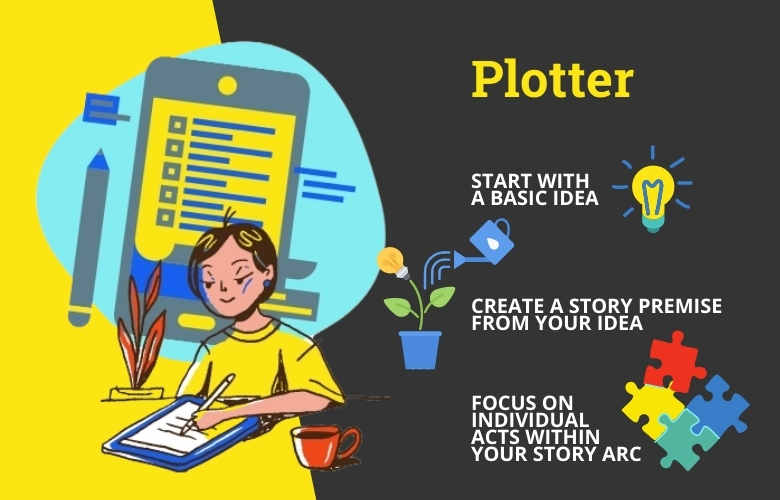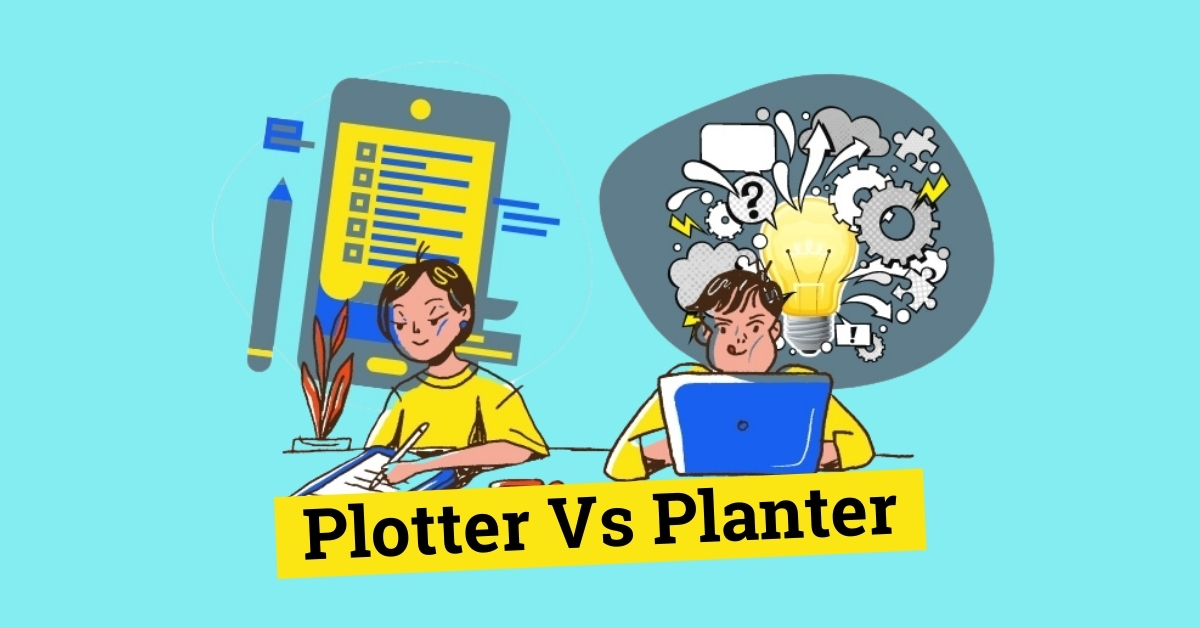I have had a couple of people ask me if “I’m a Plotter or Pantser?” and I still don’t have the exact answer to that question.
It’s like I don’t know what each of the two terms means, but I sincerely don’t know which of the two I am.
For most people though, it’s a straightforward thing; Do you outline before you start writing your novel, or do you just pick up your pen or sit down in front of the computer and wait for the story to start trickling in?
You see, I’m both. Sometimes, I plan my writing projects but also find myself winging it, and sometimes I purely “write by the seat of my pants.”
But what’s the best way to go about writing your novel? I’m about to close—once and for all—the “Plotter vs. Pantser” debate.
What Is a Pantser?
A pantser is someone who just sits down and starts writing their story—they plan very little or don’t plan at all. Pantsers see planning as something that stifles their creativity, so they just start writing without “limiting or constricting” their creative process.

What Are the Different Types of Pantsers?
Pantsers are of two different types:
- The first one is called the traditional pantser. These pantsers don’t plan at all, like AT ALL. They usually write their first draft—the whole of it—without planning a single part. The only time their process involves planning is when they get a random idea away from their computer screen or their pen and paper.
- Then we have nontraditional pantsers. This type of pantsers do not think their story through but they revise as they go. They usually think about the next part of their story, for example, they might be thinking about revising their first chapter before moving to chapter two, so, although they really don’t plot, they revise to let their minds prepare for future scenes, narrative advancement, and fill in plot holes.
Pros and Cons of Being a Pantser
Pros: The biggest pro of being a pantsers is the freedom to create—pantsers give themselves the freedom to take their story anywhere they want. The writing process of a pantser is very flexible. Pantsers let the story take its own shape (a character can die suddenly, the plot can change, etc.
Cons: With no or very little plan, it’s very easy for a pantser to lose direction and get stuck because the writer doesn’t have any navigational tools. And since the story just falls from unknown spaces, it can also just stop coming and the writer might end up with loads of unfinished works on their desk.
What Is a Plotter?
A plotter is someone who—in hairsplitting fashion—plans their story before they begin writing. Pantsers spend a lot of time in the prewriting stage—they chart out plotlines, come up with characters, and do a lot of worldbuilding. They write down the recipe before they get their pots on the stove.

Pros and Cons of Being a Plotter
Pros: Since everything is planned out ahead of time, plotters know how their story starts and ends, and there are little or no plot holes. Therefore, it’s easier for them to circumnavigate writer’s block. It’s a bit harder to get stuck because the writer already knows what’s going to happen next. Hence, writers who plan their stories write faster with fewer hurdles.
Cons: The outlines restrict plotters because once they get stuck or want to change a part of the story, they have to rewrite almost the whole outline. And rewriting the entire outline isn’t leisure, so they might end up abandoning the story.
The Writing Process for a Pantser
Well, I have already said that as a pantser all you have to do is sit down and start writing—just start writing.
Having said that, there are some steps you can’t take as a writer better as a pantser:
Have a concept before you start writing. Of course, it’s going to be a slide, but it’s good to have at least a vague idea that you can use to guide you.
Pantsing is all about feelings and impulses. You have to utilize your impulses and follow the story wherever it takes you. You don’t need an outline, so you have to immerse yourself in the story and let your mind tell you where the story is going.
Pantsing is a freestyle, conveniently so, but… it doesn’t have to have a torn-up plotline. Take a break now and then to evaluate your work. Do this to fill up any plot holes or tie some loose ends that might be distorting the plot.

Edit! Edit! Edit! Just because you are pantsing doesn’t mean that you are exempted from editing your work. Your reader won’t give a damn whether you were pantsing or not, they want a story that has structure and shows a cohesive arc.
So, you are freewriting and the story goes on and on, and… when does it end? You didn’t plan this but you know that the story has to end at some point. You have to have a resolution. Since you don’t have a planned ending, you have to notice when your work is approaching its endpoint. The endpoint has to be as natural as it can be, so you have to be so attentive and immersed in your story’s progression to find a point that can naturally resolve your plot.
The Writing Process for a Plotter
Unlike pantsing, you can plot using a variety of ways or methods. You will probably have to experiment to find a technique that works for you. Here are some steps that can help you become a better plotter:
Ideas! Ideas! Ideas. The very first step of plotting involves generating story ideas. You can brainstorm the ideas on your own or work with writing prompts. I can’t tell you which method is better, but whichever method helps you come up with a good idea or set of ideas that you can turn into an effective plot is the best for you.
The simplest way to start plotting is to come up with a compelling premise. You have to turn a basic idea into a story premise, and one way of developing this basic idea into a story is the so-called snowflake method. The snowflake method is like constructing a structure from the core (the premise or theme) and then you start building other pieces around the premise until it becomes a full-length narrative.
Your focus should not be on building the whole thing at once; rather, you have to focus on individual acts within your story arc. As you stitch these acts together, you will see a full-length narrative starting to take shape.

You also have to come up with detailed character arcs and have to make sure that your MC has a compelling motivation and backstory. While plotting, you have to ensure that your characters are strong, realistic, and nuanced.
If this is not short fiction, then you have to build subplots—you can’t do without them. After figuring out your main plot, start weaving in subplots. Good writers know how to engraft subplots to the main seamlessly.
A good plot outline can compile and detail the main story and individual plot points, and it is so comprehensive that anyone who can read English can understand the narrative.
However, the outline isn’t done yet. Before or when you start writing, you start noticing some missing elements and loose ends, so you have to return to your plot and outline to tie up these and fill any plot holes.
How to go from Pantser to Plotter
There are a lot of famous pants who claim to write the whole novel without outlining a single section. But you should know that a little planning goes a long way.
However, moving away from pantsing is very hard, not as hard as going through the eye of a needle, but uh… close.
But there’s a method of outlining that I just stumbled upon and it’s called the flashlight method of writing. I believe that this is the bridge that every pantser needs to cross over to the plotting side. By using this method, you don’t have to outline the whole story or novel, you just have to outline enough scenes to take you through a chapter.
The idea is to outline only the part you are about to write, just like the way a flashlight only illuminates the nearest area.
This way, you don’t have to worry about the next chapter. The spirit of pantsing that remains in you will be happy, and the new spirit of plotting will also be satisfied to an extent.
Eventually, you’ll get used to plotting and the pantser in you will fade away.
How to Be Both a Plotter and a Pantser
Yes, you can be both—you can compromise some things and be a Pantser who entertains some level of planning before writing. Being both can save you a lot of time while unleashing the creative genius in you.
You can at least plan out your major plot points, and those might act as beacons when you start pantsing it.
You don’t have to plan everything; forget the actual scenes and consider starting by separating your basic story idea into three main acts. Expand what happens in the three parts of your story.
For example:
- Act 1: Hero is faced with a problem
- Act 2: Hero tries to solve the problem
- Act 3: Hero solves the problem and vanquishes the evil behind the problem.
You can then use some sort of adapted flashlight method to expand the path that the hero is going to take you from ‘Act 1’ to ‘Act 3’.
Famous Plotters and Pantsers
On both sides of the aisle are names of great authors who’ve used methods that work for them regardless of the cons. This just goes to prove that it really doesn’t matter how you treat your pre-writing process. As long as it works for you, you will churn out a compelling piece.
Plotters
The list of famous plotters includes J.K. Rowling, E.L. Stein, John Grisham, Sylvia Plath, Gay Talese, Arthur Miller, and Joseph Heller.
Pantsers
The list of some of the most famous writers who are pantsers includes Stephen King, Margaret Atwood, Pierce Brown, David Morrel, and Chuck Wendig.
Summary
Before I wrap up, I would like to remind you that it’s not about what works for everyone, but what works for you that matters.
You can choose to be a panther or a plotter, or both. You don’t have a lot to lose when you choose to plan out the basic plot points of your story before letting your creative side loose.
However, if you don’t want to compromise, it’s perfectly okay, I’ve already listed a bunch of names that profited from using either method.
